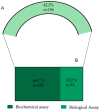Opuntia ficus-indica Fruit: A Systematic Review of Its Phytochemicals and Pharmacological Activities
- PMID: 36771630
- PMCID: PMC9919935
- DOI: 10.3390/plants12030543
Opuntia ficus-indica Fruit: A Systematic Review of Its Phytochemicals and Pharmacological Activities
Abstract
The use of Opuntia ficus-indica fruits in the agro-food sector is increasing for a multiplicity of players. This renewed interest is, in part, due to its organoleptic characteristics, nutritional value and health benefits. Furthermore, industries from different sectors intend to make use of its vast array of metabolites to be used in different fields. This trend represents an economic growth opportunity for several partners who could find new opportunities exploring non-conventional fruits, and such is the case for Opuntia ficus-indica. O. ficus-indica originates from Mexico, belongs to the Cactaceae family and is commonly known as opuntia, prickly pear or cactus pear. The species produces flowers, cladodes and fruits that are consumed either in raw or in processed products. Recent publications described that consumption of the fruit improves human health, exhibiting antioxidant activity and other relevant pharmacological activities through enzymatic and non-enzymatic mechanisms. Thus, we provide a systematic, scientific and rational review for researchers, consumers and other relevant stakeholders regarding the chemical composition and biological activities of O. ficus-indica fruits.
Keywords: antioxidants; betalains; bioactive compounds; food and health; phenolics; prickly pear.
Conflict of interest statement
The authors declare no conflict of interest. The funders had no role in the design of the study; in the collection, analyses, or interpretation of data; in the writing of the manuscript; or in the decision to publish the results.
Figures








Similar articles
-
Sensory attributes, physicochemical and antioxidant characteristics, and protein profile of wild prickly pear fruits (O. macrocentra Engelm., O. phaeacantha Engelm., and O. engelmannii Salm-Dyck ex Engelmann.) and commercial prickly pear fruits (O. ficus-indica (L.) Mill.).Food Res Int. 2021 Feb;140:109909. doi: 10.1016/j.foodres.2020.109909. Epub 2020 Nov 24. Food Res Int. 2021. PMID: 33648207
-
Opuntia ficus-indica (L.) Mill. - anticancer properties and phytochemicals: current trends and future perspectives.Front Plant Sci. 2023 Oct 4;14:1236123. doi: 10.3389/fpls.2023.1236123. eCollection 2023. Front Plant Sci. 2023. PMID: 37860248 Free PMC article. Review.
-
Influence of cultivar and origin on the flavonol profile of fruits and cladodes from cactus Opuntia ficus-indica.Food Res Int. 2014 Oct;64:864-872. doi: 10.1016/j.foodres.2014.08.021. Epub 2014 Aug 29. Food Res Int. 2014. PMID: 30011726
-
By-products of Opuntia ficus-indica as a source of antioxidant dietary fiber.Plant Foods Hum Nutr. 2010 Sep;65(3):210-6. doi: 10.1007/s11130-010-0176-2. Plant Foods Hum Nutr. 2010. PMID: 20623195
-
Physicochemical, Nutritional, and Medicinal Properties of Opuntia ficus-indica (L.) Mill. and Its Main Agro-Industrial Use: A Review.Plants (Basel). 2023 Mar 30;12(7):1512. doi: 10.3390/plants12071512. Plants (Basel). 2023. PMID: 37050137 Free PMC article. Review.
Cited by
-
New Functional Foods with Cactus Components: Sustainable Perspectives and Future Trends.Foods. 2023 Jun 27;12(13):2494. doi: 10.3390/foods12132494. Foods. 2023. PMID: 37444232 Free PMC article. Review.
-
Effect of Opuntia ficus-indica Extract in Pro-Healthy Chicken Patties: Physicochemical Properties and Oxidative Stability.Foods. 2024 Dec 9;13(23):3970. doi: 10.3390/foods13233970. Foods. 2024. PMID: 39683043 Free PMC article.
-
Structure-Function Relationships and Health-Promoting Properties of the Main Nutraceuticals of the Cactus Pear (Opuntia spp.) Cladodes: A Review.Molecules. 2024 Oct 7;29(19):4732. doi: 10.3390/molecules29194732. Molecules. 2024. PMID: 39407660 Free PMC article. Review.
-
Thermo-Responsive Hydrogel Containing Microfluidic Chitosan Nanoparticles Loaded with Opuntia ficus-indica Extract for Periodontitis Treatment.Int J Mol Sci. 2024 Aug 29;25(17):9374. doi: 10.3390/ijms25179374. Int J Mol Sci. 2024. PMID: 39273327 Free PMC article.
-
The Potential of Hydrogel Preparations Containing Plant Materials in Supporting the Treatment of Vaginal and Vulvar Infections-Current State of Knowledge.Polymers (Basel). 2025 Feb 11;17(4):470. doi: 10.3390/polym17040470. Polymers (Basel). 2025. PMID: 40006132 Free PMC article. Review.
References
-
- De Leo M., De Abreu M.B., Pawlowska A., Cioni P., Braca A. Profiling the chemical content of Opuntia ficus-indica flowers by HPLC–PDA-ESI-MS and GC/EIMS analyses. Phytochem. Lett. 2010;3:48–52. doi: 10.1016/j.phytol.2009.11.004. - DOI
-
- Abascal K., Yarnell E. A Review of Prickly Pear the Upscale Medicinal Food. Altern. Complement. Ther. 2000;6:265–271. doi: 10.1089/act.2000.6.265. - DOI
-
- Kluge M., Ting I.P. Crassulacean Acid Metabolism: Analysis of an Ecological Adaptation. Volume 30 Springer Science & Business Media; Berlin/Heidelberg, Germany: 2012.
-
- Ayadi M., Abdelmaksoud W., Ennouri M., Attia H. Cladodes from Opuntia ficus indica as a source of dietary fiber: Effect on dough characteristics and cake making. Ind. Crop. Prod. 2009;30:40–47. doi: 10.1016/j.indcrop.2009.01.003. - DOI
Publication types
Grants and funding
LinkOut - more resources
Full Text Sources
Molecular Biology Databases

